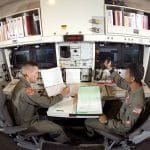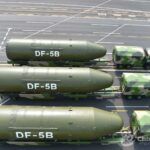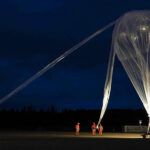Cool your jets: Some perspective on the hyping of hypersonic weapons
By Ivan Oelrich | January 1, 2020
Cool your jets: Some perspective on the hyping of hypersonic weapons
By Ivan Oelrich | January 1, 2020
The international competition to develop and deploy hypersonic weapons is heating up. In 2018, Russian President Vladimir Putin used his annual state of the nation address to announce the deployment of hypersonic weapons, declaring that they were invulnerable to US defenses and were specifically developed in response to American abrogation of the Anti-Ballistic Missile Treaty (Putin 2018; Cebul 2018). For its part, the US military has long supported research into hypersonic vehicles (Woolf 2019). However, some experts claim that both Russia and China are ahead of the United States in the development of hypersonic weapons (Davenport 2018), a viewpoint that Michael Griffin, head of Pentagon research and engineering, seemed to endorse in 2018. Speaking at a conference, Griffin said that hypersonic weapons, and defense against them, were his highest technology priorities (Tirpak 2018; Smith 2019), and the Pentagon’s budget request for hypersonic-related research has increased accordingly, jumping to $2.6 billion for fiscal 2020 (Sayler 2019).
Many extraordinary claims have been made both about the capabilities of hypersonic missiles and about the dire consequences of not developing these new weapons. Most public and trade press reports seem quite uncritically dazzled by the asserted new capability, and what has been written outside the scientific literature seems to accept that, given funding and research, hypersonic weapons can live up to the fanfare. Yet there remain some daunting engineering challenges (Leyva 2017) that will require a lot of money to overcome. And, even then, there are some physical limitations that will never be overcome. There will always be engineering tradeoffs, so that when hypersonic weapons are described as being able to do X, Y, and Z, it is more accurate to say they can do X or Y or Z.
This article lays out some of these physical limits and engineering tradeoffs and weighs the pros and cons of hypersonic weapons. As will become clear, many of the claims about the revolutionary nature of hypersonic weapons do not withstand scrutiny, particularly when compared to alternatives. Their capabilities are not new, and today most of the missions proposed for hypersonic weapons could be accomplished cheaper and with less technical risk simply by modifying existing ballistic missiles.
Hypersonic weapons: The basics and the inherent tradeoffs
The term “hypersonic” is almost always defined as five times the speed of sound. The speed of sound in air varies with temperature and pressure but is equivalent to about 340 meters per second—or 1,224 kilometers per hour (km/hr)—near the surface of the Earth. Mach 1 is defined as the speed of sound, in whatever atmosphere, so hypersonic is equal to Mach 5, or a bit more than 6,000 km/hr. While the speed of sound is a real physical phenomenon, the designation of hypersonic to mean five times as fast as the speed of sound is a bit arbitrary (since it could have just as easily been 4.7 or 5.2 times the speed of sound). Nevertheless, Mach 5 is roughly the speed at which an object’s shockwaves heat the surrounding air so much that plasma effects (more on those later) need to be considered. Based on this definition, weapons that travel at hypersonic speed are not new. Indeed, the first modern ballistic missile, Germany’s World War II V-2, developed in the 1940s, was capable of traveling about 5,400 km/hr—just a whisker shy of making the cut for being hypersonic (German Army 1944, p. 5). More modern intermediate and long-range ballistic missiles travel much faster—Mach 15 and higher. In any case, the defining characteristic of hypersonic weapons is speed.
There are two distinct types of hypersonic vehicles. First are boost-gliders, which are accelerated to high speed with some sort of rocket booster, perhaps even an existing ballistic missile booster, and then coast unpowered simply from their own momentum. Second, there are hypersonic cruise missiles, which have engines that use oxygen from the air and produce thrust during their flight, just as other aircraft do. These two types, despite being quite different from one another, are often conflated in the non-technical literature. Most of the current effort is directed toward the far easier boost-glide vehicles. For that reason, most of the discussion focuses on boost-gliders, but I will return to cruise missiles briefly at the end.
Hypersonic gliders are characterized by their speed, range, and maneuverability, but there are direct tradeoffs among all three performance parameters. Once the booster rocket burns out and falls away, the glider’s only “fuel” is its momentum and, to a lesser extent, its altitude, which can be traded for speed to some extent. The glider experiences a certain amount of drag, which continuously slows it down along its course. So the first tradeoff is between speed and range. The farther it glides—that is, the greater its range—the slower it is traveling when it reaches its target. So, while a glider may start at, say, Mach 20, it will not be going anywhere near as fast when it approaches a distant target. How quickly it slows down depends on the drag (and mass) of the glider. Higher drag, of course, slows the glider down more quickly.
An important characteristic of any aircraft is the ratio of lift to drag, usually written as L/D. In straight and level flight, the only thing the lift must do is counteract gravity. So, in that case, lift is constant and equal to the weight of the aircraft. All else being equal, a higher L/D, meaning lower drag, is a good thing to have. Competition sailplanes have an L/D of about 40, commercial airliners about 20, and hypersonic gliders have an L/D in the single digits (Anderson 2001).
The next tradeoff is between speed (and range) on one hand, and maneuverability on the other. Isaac Newton tells us that if an object is moving forward and we want it to turn toward the right, then we have to give it a push toward the right. An aircraft provides that push with the lift from its wings. (Of course, hypersonic gliders usually do not have wings as such and get lift from the shape of the body of the glider, but the effect is the same.) In level flight, the lift of the wings is purely directed upwards but when an aircraft is banking, a vertical component of the lift is still counteracting gravity while a horizontal component of the lift is pushing the aircraft to one side to effect a change of direction. The combined vertical and horizontal components of lift are greater than the lift required simply to counteract gravity. That is, a turn requires more lift than flying straight and level. More lift with a constant L/D means more drag. Turns increase drag.
If we define the lift needed to counteract gravity as 1, and if a glider doubles that lift to 2 in a banking turn, it can keep a vertical component of force of 1 and still have left over a horizontal component of force of 1.73. With a horizontal turning force of 1.73, a glider going at Mach 10 would have a turning radius of about 680 km. And, with a constant L/D, this doubling of the lift would double the drag and double the rate at which the glider slows down, because the glider has no compensating thrust. So even extremely gentle turns exact a big penalty in drag, hence in speed and range. High-acceleration jinking, either to avoid interceptors or home in on a target, will come at a very steep price in speed.
Hypersonic boost-glide missions versus ballistic missiles
Most of the missions proposed for hypersonic gliders, such as a quick attack on a fleeting target, are already met, or could be met, just as well by ballistic missiles. In the US context, hypersonic weapons figure prominently in the Prompt Global Strike program, which is still in development. The stated mission requirements for Prompt Global Strike usually include being able to precisely hit targets over much, if not all, of the world within about an hour using conventional warheads. (If the hour includes the time needed for targeting, mission planning, and deciding to launch, then the flight time requirements become almost impossible to meet.) Interestingly, before hypersonic weapons stole the show, an early candidate for fulfilling this mission was a modified ballistic missile that could be launched from existing nuclear-armed submarines (Acton 2013). Congress resisted the proposal not primarily because of skepticism about whether it would work, but largely over concerns that Russia and China, having no way to know whether a missile launched from a submarine was armed with a conventional or a nuclear warhead, would assume the worst and respond as though it were nuclear (Woolf 2019, 30–32). Such a scenario would risk escalating a conventional war into a nuclear one. Avoiding the ambiguity, along with mirror-imaging the Russian and Chinese hypersonic programs, is therefore a major justification for US development of hypersonic weapons. Proponents of the US hypersonic program say that none of the missiles will ever carry nuclear warheads, avoiding the ambiguity problem. This is hardly reassuring to Russia and China, of course, because no nuclear system would ever be tested with an actual nuclear warhead and, regardless of testing, there is no way for Russia and China to be sure one way or the other while the missile is in flight. If current air-breathing cruise missiles could be armed with either conventional or nuclear weapons, then so could hypersonic gliders.
With the US abrogation of the Intermediate-range Nuclear Forces (INF) Treaty, many more ballistic missile options for Prompt Global Strike could open up, at least in theory. (Finding host countries in which to base the shorter-range missiles, however, could be a political challenge but that will be true of hypersonic gliders as well.)
Of course, the United States is considering hypersonic gliders for far more missions than Prompt Global Strike; they are envisioned to be key weapons for attacking mobile missiles and air defense radars in a conventional war with a peer competitor, say, Russia or China. Still, all of these missions could be met by ballistic missiles—perhaps not ballistic missiles deployed today but missiles that could be developed using lower-risk technology, perhaps by modification of existing weapons. In the following discussion of hypersonic boost-glide vehicles and their characteristics, I will touch on corresponding ballistic missile capabilities at each point.
Speed
Speed is what supposedly sets hypersonic weapons apart, but they may not actually be much faster than ballistic missiles even in the best of circumstances. For a given amount of rocket push, called impulse, there is a ballistic missile trajectory that maximizes range for a given payload. This is called the minimum energy trajectory. For long-range ballistic missiles, this is a high arching path that lies mostly above the atmosphere, reaching altitudes well over 1,000 km, compared to hypersonic vehicles that would typically travel below 50 km in altitude. So, while rockets may have higher top speeds than hypersonic competitors, they travel a much longer distance to get from point A to point B on the surface of the Earth when following an optimal path and, in some special circumstances, a hypersonic vehicle in the upper atmosphere could cover the distance in less time despite having a lower average speed.
Rockets can, however, take a path higher than optimal, called a lofted trajectory, or lower than optimal, called a depressed trajectory. In either case there will be a reduction in either range or payload. But a ballistic missile traveling on an extremely depressed trajectory has a significantly reduced flight path compared to a minimum energy trajectory and has, therefore, a much shorter flight time.
Depressed trajectory missiles, especially launched from submarines, have long been of interest to military planners because their flight times are short enough to allow surprise attacks against air bases and communications centers in the first strike of a nuclear war (Gronlund and Wright 1992). A depressed trajectory for a ballistic missile requires more than simply changing some navigational inputs. The rocket may be subject to greater stress and, because the warhead reenters at a very shallow angle, it spends more time in the atmosphere and is exposed to higher temperatures and may, therefore, need greater heat resistance than a normal reentry vehicle. Nevertheless, even though the warhead may need some guidance and maneuverability to compensate for greater effects of unpredictable fluctuations in air density, the thermal challenge is not greater than that faced by a hypersonic glider. The United States has reportedly tested at least once a submarine missile on a depressed trajectory with a guided warhead (Kristensen 2006, p. 39).
A study by the Defense Science Board, a committee of civilian experts that advises the Pentagon on scientific matters, calculates that a notional ballistic missile on a depressed trajectory could travel 6,700 km in 17 minutes (Defense Science Board 2009, Appendix D). That corresponds to an average speed of about Mach 20, much higher than the average speed of any proposed hypersonic glider.
Of course, a depressed trajectory ballistic missile and a hypersonic glider are actually not all that different. Both would use a rocket booster to accelerate more or less vertically to get out of most of the atmosphere as quickly as possible. The difference between them is that if reentry into the atmosphere takes place 10 percent of the way to the target, we would call the vehicle a hypersonic glider, whereas if the reentry takes place 90 percent of the way to the target, we would call the vehicle a depressed trajectory ballistic missile with a guided warhead. But the vehicle could be designed to reenter anywhere between 10 and 90 percent of the way along its path. As an example, the reentry vehicle in the notional depressed trajectory presented in the Defense Science Board study reenters the atmosphere at a 10 degree angle going about Mach 20. At that point it would be in an ideal state to begin a hypersonic glide, substantially increasing its range. The difference between hypersonic gliders and depressed trajectory ballistic missiles should be seen as points along a spectrum, not a binary choice.
Penetrating defenses: warning time, maneuver, radar visibility
Many descriptions of hypersonic weapons note that they will be difficult to impossible to defend against (Thompson 2019; Macias 2018). But this situation is nothing new: None of the big military powers, much less North Korea and Iran, can now defend effectively against long-range ballistic missiles. (Nor, apparently defend against subsonic cruise missiles, as demonstrated by the 2019 attack on a Saudi oil refinery [Taylor 2019].) Moreover, when hypersonic missiles do appear to have a defense penetration advantage compared to ballistic missiles, it comes about mostly from ignoring well-developed penetration capability and tactics, such as terminal maneuver, that are available to ballistic missiles but that are simply not currently exploited to the extent that they could be.
Descriptions of hypersonic weapons cite three main characteristics that change the defense equation relative to ballistic missiles: a lower trajectory resulting in less warning time for ground-based radars, maneuverability in the atmosphere, and reduced radar cross-section. But, as will become clear, in all three cases, the advantage of hypersonic gliders is overstated.
The trajectories of gliders are at a much lower altitude than the most efficient ballistic missile trajectories, so any defending ground-based radar could see approaching hypersonic vehicles much later simply because the curvature of the Earth will block them for longer (see the figure in The Economist 2019). However, just because there is a line-of-sight to the target does not mean that a radar can detect a target. The radar echo decreases with the fourth power of the distance; that is, when the distance doubles, the echo is only one sixteenth as strong, so only large, powerful radars will be able to see long-range ballistic missiles that are at the peak of their trajectories. In addition, the warning time advantage of hypersonic gliders depends somewhat on pitting them against ballistic missiles traveling on a minimum energy trajectory. When compared to a missile traveling on a depressed trajectory, the advantage is substantially reduced.
The significance of any difference in warning time also depends on the details of the defensive system countering the hypersonic gliders or ballistic missiles. For defense of a large area, long-range intercepting missiles will not be sitting next to the radars that will first detect attacking weapons. Current missile defenses such as the Ground-based Midcourse Defense system or the Aegis-based defense of Europe depend on space-based infrared and radar sensors and layers of ground-based radars. Warning time for a long-range ballistic missile attack does not depend on the maximum line-of-site from the launch point of the interceptors to the target, called the radar horizon, nor would it when defending against hypersonic attackers. In shorter-range tactical situations, the defending missiles are defending themselves and nearby forces, called a point defense. In this case, the warning and guidance radar would often be deployed alongside the interceptors as with, for example, US Patriot missiles. Even if flying lower than a ballistic missile, a hypersonic glider is still high up. At an altitude of 30 km, the radar horizon is 620 km. If the glider is traveling at Mach 10, that still gives three minutes of warning—enough time for a point defense interceptor to fly out to engage. If the detection range is limited not by the radar horizon but by the sensitivity of the radar, then the reaction time depends on when the target is first detected as well as its speed, and ballistic missile warheads will be faster in most cases.
When cruising to their target, hypersonic gliders will, indeed, have the upper hand against most currently deployed defensive systems simply because the interceptor missiles are not designed to operate at typical hypersonic altitudes. For example, the US Aegis anti-missile system has an interceptor that operates in the near vacuum of space but does not perform well even in tenuous atmosphere. The Russian S-400, perhaps the most capable anti-air missile in the world, is long range, is itself hypersonic and maneuverable, but is almost certainly not designed to operate at the 30 km altitude typical of hypersonic gliders. The US Terminal High-Altitude Area Defense, or THAAD, however, is a widely deployed system that operates just at and beyond the edges of the atmosphere and would be a promising basis for a defense against hypersonic weapons. While developing new warheads for an array of defensive weapons that can attack hypersonic gliders during their cruise phase will be expensive and technically challenging, the corresponding problem is defending against a ballistic missile in mid-flight, which is even more difficult.
Second, consider the maneuverability of hypersonic gliders—probably the most common characteristic cited for their invulnerability. General Paul Selva, vice chairman of the Joint Chiefs of Staff, was quoted in 2019 as saying, “The best layman’s description I’ve heard of hypersonics as a strategic threat goes something like this: If you’re going Mach 13 at the very northern edge of Hudson Bay, you have enough residual velocity to hit all 48 of the continental United States. . . . You can choose . . . to make a right or a left turn and hit Maine or Alaska, or you can hit San Diego or Key West. That’s a monstrous problem” (Cohen 2019).
General Selva’s description seems to contrast the near-impossible problem of defending against hypersonic gliders with some much easier existing defensive problem. But the United States cannot now defend against a ballistic missile attack that Russia or China might launch. Indeed, statements of US missile defense strategy explicitly state that US missile defenses are aimed at rogue states and not designed for, nor intended for, defense against Russia and China. This is done to discourage destabilizing counter-moves by either country. The United States depends primarily on nuclear deterrence to dissuade, rather than defend against, nuclear attack from Russia and China (Office of the Secretary of Defense 2019, 8).
Moreover, as far as can be determined from the unclassified literature, during the Cold War, the United States and the Soviet Union were not deploying simple countermeasures on their ballistic missiles, which might include decoys, flares, chaff, signature reduction, or jamming (Sessler et al. 2000), but only because there was not an effective mid-course defensive system to contend with at the time. Now that the United States is developing defensive missiles, Russia could deploy well-known countermeasures. So, while point defense against medium-range tactical missiles is challenging but possible, defense of the whole of the United States against a sophisticated attack with long-range ballistic missiles is still easily compromised by countermeasures.
And ballistic missiles still have a few other tricks up their sleeves. For example, maneuverable re-entry vehicles, including the Mk 500 Evader and the Advanced Maneuvering Re-entry Vehicle, were developed four decades ago to confound Soviet missile defenses and were considered at the time to be “off the shelf” technology, but were never deployed because Russian defenses were not considered robust enough to make them worthwhile (Bunn 1984, 89–96). Sandia’s SWERVE maneuverable warhead was tested in the 1980s but never deployed. The Pershing II intermediate-range missile, deployed in 1983, had a warhead that performed a 25-g pull-up maneuver, although primarily not to evade anti-missile defenses but to slow the vehicle enough that the terrain-matching radar in its nose could find fixed targets on the ground (Perrett et al. 2014). Even the North Korean ballistic missile development program, far less sophisticated than the US capabilities of the 1980s, seems to be experimenting with maneuverable warheads (Sanger and Broad 2019). All of these defense penetration techniques would also be available to hypersonic gliders in their terminal dive, but there is no reason to think the gliders would be more effective simply because they got to the target area by gliding rather than by traveling on a ballistic trajectory.
In short, not being able to defend the continental United States from a long-range missile threat, whether hypersonic or ballistic, is neither new nor a problem that the United States will solve anytime soon. In fact, much of what is written about hypersonic gliders only makes sense if one assumes a ballistic missile defense that is far more effective than it actually is. Implications that hypersonic gliders pose a new defense problem are therefore entirely misleading.
Third, hypersonic vehicles travel so fast and the shockwaves they form heat the air so much that the air ionizes, forming a plasma that surrounds the vehicle. Several press reports suggest that this plasma cloud absorbs radio waves, making the vehicle invisible to radar.
The effect of plasmas on radar cross-section has been studied since the early days of the Space Age (Darnell 1966; Marini 1967). The plasma, or ionized gas, surrounding a hypersonic vehicle interacts with radio waves. The plasma has a certain electromagnetic resonance frequency depending on the temperature and density of the gas (also depending on the composition of the gas, but we are only interested in the case where the gas is air) and the thickness of the plasma layer. If the radio waves match the frequency, they will be absorbed, reducing the radar cross-section. Lower frequencies will reflect off the plasma and higher frequencies will go through the plasma and reflect off the vehicle. So, radar cross-section reduction will occur only at a particular frequency range. Most modern radars can operate over a band of frequencies, primarily as a way to overcome radar countermeasures.
Under some plasma conditions and some radar frequencies, the radar cross-section is actually enhanced. To manage the heat load and maximize range, a hypersonic glider will not have a lot of choice about combinations of speed and altitude and cannot, therefore, manage its speed profile in a way to tailor the plasma envelope. The material and aerodynamic challenges of flying hypersonic are so great that there will be little leeway to accommodate stealthy shapes or materials. In sum, it is unlikely that hypersonic gliders will have radar cross-sections meaningfully smaller than those of comparable ballistic missile warheads.
Finding and destroying targets
Is there a substantial difference between hypersonic gliders and ballistic missiles when it comes to finding targets for a long-range attack? To answer this question it is important to first draw a distinction between stationary and mobile targets. Stationary targets can be researched at least some moments before launching a strike or perhaps for years before the beginning of a war. Attackers can then aim, not at a target per se, but at a particular latitude and longitude. Of course, even in these situations nothing is guaranteed. The opening attack in the 2003 Iraq War was meant to catch Saddam Hussein in an underground bunker at Dora Farms, near Baghdad. A combination of cruise missiles and GPS-guided bunker-busting bombs dropped from stealth fighters pounded the target. Subsequent investigation revealed that not only was Saddam not in the bunker, there was no bunker (Roberts 2003).
In attacks against smaller, less sophisticated enemies, US weapons might be able to use GPS to navigate to a pre-designated geographic coordinate, although jamming of the navigation signals is a continuously developing threat. If GPS is available, it would be available to both hypersonic gliders and ballistic missile warheads, although both would have to be moving slowly enough, below Mach 10–12, to reduce their plasma envelopes so that the signals could get through (Defense Science Board 2009, 26–28). Ironically, hypersonic missiles, defined by their speed, would have less of a problem because in almost all cases they will have slowed down to less than Mach 10 by the end of their flights. Intermediate- and long-range ballistic missiles would have to execute some sort of pull-up maneuver specifically to burn off enough speed to allow GPS reception. As mentioned above, the Pershing II was able to conduct just such a maneuver. Longer-range ballistic missiles would enter the atmosphere at higher speeds than did the Pershing, but building the maneuvering warhead for them is no more challenging than building a hypersonic glider.
More advanced adversaries, specifically China and Russia, might deny the United States use of GPS, either through jamming and spoofing or by direct attack on the satellites. Then both ballistic missiles and hypersonic gliders could get close to the target using inertial guidance—that is, instruments that measure the accelerations and turns of the vehicle while in flight, feeding their data into a computer where they would be added up to calculate the weapon’s position at any time. For a nuclear warhead, with its enormous destructiveness, inertial guidance alone seems to be adequate.
To hit within the few meters required of conventional weapons would probably require some sort of terminal guidance for the warhead. Building sensors for terminal guidance against stationary targets does not require detecting the target itself; it only requires enough information to calculate the weapon’s position. Again, using the Pershing missile radar example, it did not look directly at the target but at a ring of terrain around the target. When the radar returns matched a digital map stored in an onboard computer, the warhead knew that the target lay at the center of that ring. The details of how such sensors operate is not as important to the current discussion as is the key point that, whatever approach is taken, it could be used by either ballistic or hypersonic weapons, as long as a longer-range ballistic weapon is allowed enough maneuver to bleed off some speed and shed its plasma envelope.
Mobile targets present thornier problems to any conventionally-armed, long-range weapon system because a mobile target can move farther during the flight of an attacking weapon than the lethal radius of the weapon. As Stephen Biddle and I have written elsewhere, there are serious barriers to tracking mobile targets at sea or on land (Biddle and Oelrich 2016). Finding moving land targets from aircraft would be particularly difficult if the defender exploited even simple and cheap countermeasures to blend into the complex background of the Earth. Traveling at high speeds and altitudes will only increase the challenge. Infrared sensors on the vehicle will be affected by the high temperature of the vehicle itself. Hypersonic aerodynamics will constrain the size and placement of radar antennas, which will limit resolution. In general, an attacking weapon needs to fly fast, since an additional few minutes of warning could make a huge difference in the enemy’s ability to pack up and move a radar or erect and launch a mobile missile, yet flying fast makes detection of targets harder, and this is true for both hypersonic gliders and ballistic missile warheads.
The idea of attacking surface targets with kinetic energy weapons goes back to when people first started throwing rocks at one another, but today we are in a different epoch. A kilogram of TNT contains 4.2 million joules of chemical energy. A one-kilogram brick traveling three kilometers per second (almost Mach 9) would have the same amount of kinetic energy, so above a certain speed a chemical explosive warhead is superfluous—the missile gets as great a destructive effect by simply ramming the target. Science fiction writer Jerry Pournelle is credited with developing, while working at Boeing in the 1950s, the idea of parking multi-ton tungsten cylinders in near-Earth orbit, informally called “rods from god,” to be decelerated enough to enter the atmosphere and fall onto a hard target on the ground where they would strike with great effect simply because of their very high speed and mass and, thus, high kinetic energy (Shainin 2006). The concept fails in practice because of the extremely high cost of lofting heavy payloads into orbit. Hypersonic gliders could exploit their kinetic energy in this way if they could keep their speed high enough up to the end of their flights. Diving from a great altitude could help somewhat, but this alone will not provide a lot of additional kinetic energy. This is true in part because as the glider gets closer to the surface of the Earth, the air density quickly rises and the drag on the gliders increases, working against the acceleration provided by gravity. The same kinetic energy effect could more easily be achieved with a ballistic missile re-entry vehicle outfitted with a terminal booster, which would accelerate the warhead down toward its target just before impact (Garwin 2003, 4).
Kinetic energy attack requires great precision, and there is nothing fundamental about a hypersonic vehicle that makes it intrinsically accurate. To fly stably, however, the glider needs some sort of aerodynamic control so that, if it has some sort of guidance as discussed above, it can apply that guidance information to the control system, adjust its course, and home in on a target. Note, however, that high kinetic energy weapons face a conundrum: greatest lethality requires the highest speeds, which will be in the plasma region, making terminal guidance impossible. So there is a tradeoff between accuracy and destructiveness.
Of course, hypersonic gliders do not have to exploit their potentially high speed; they could be armed with more conventional warheads or submunitions that would have effects similar to those of existing delivery means. Guiding hypersonic gliders to target would be more difficult than, say, for current subsonic cruise missiles but no more difficult than a ballistic missile alternative. Any of several delivery systems could be used for a precision strike, although one should be very careful not to overestimate their effectiveness; Syria resumed flights within hours after the Shayrat airfield was hit by 59 US cruise missiles in 2017 (Ensor 2017).
Hypersonic cruise missiles
The discussion to this point has considered only hypersonic gliders, which are accelerated to high speed by a fairly conventional rocket booster and then coast to their target simply by dint of their momentum. However, there is an alternative option: hypersonic vehicles could be powered, allowing them to cruise at a steady speed and altitude. Almost all current attention and development effort is directed to gliders in large part because hypersonic propulsion is extremely challenging.
In theory, a hypersonic air-breathing engine could allow greater range than a ballistic missile of the same initial weight because the vehicle does not need to carry an oxidizer to mix with the fuel as a rocket does, it simply scoops up the oxygen-laden air and so only has to carry the fuel portion of the propellant. In practice, developing and operating such an engine is fiendishly tricky. All engines need to compress the air—which also heats it up—before adding fuel to further raise the temperature. Ramjet engines do this by pushing the vehicle—and its air intake—at supersonic speed through the air. As the air piles up in the intake, it is compressed. Hypersonic aircraft could do this but, if the air is decelerated too much, then the compression and associated heating is so great that adding fuel does not further raise the temperature. That is, the fuel doesn’t burn; it remains in a disassociated state due to the extreme temperature. So hypersonic engines need to only partially decelerate the air to limit temperature rise, leaving the air supersonic in the combustion chamber. Hence the term “scramjet” or “supersonic combustion ramjet.” Operating a scramjet has been likened to “keeping a match lit in a hurricane” (Creech 2004).
Maintaining the exacting conditions of the shock wave entering the engine could constrain maneuver of the vehicle because the vehicle itself and its orientation to the airflow are actually part of this temperamental engine. Maintaining the proper temperatures and densities inside the engine could also constrain the operation of the engine to certain combinations of speed and altitude.
Finally, because the scramjet engine would produce no thrust at low speeds, the vehicle would have to be accelerated by some other jet or by rocket engines, further complicating the design.
Overhyped hypersonics
In conclusion, if engineers can master the formidable technical challenges, hypersonic weapons will offer some new capabilities, but these are not quite so revolutionary as they are often presented. Much of the appeal of hypersonic weapons depends on comparing them to ballistic missiles as they are deployed today. But to truly compare apples to apples, hypersonic weapons should be pitted against ballistic missiles as they could be with simple modifications. For example, claims of hypersonic weapons’ short time to target should not be compared to minimum energy ballistic trajectories but to already demonstrated depressed trajectory missiles.
And while claims that hypersonic weapons are “unstoppable” may be true, the United States currently has no effective defense against a sophisticated ballistic missile attack of even moderate size, so ballistic missiles are also unstoppable. Many articles discussing hypersonic missiles leave the reader with the impression that ballistic missile defense is a done deal and hypersonic attack undoes all that, which is a major misrepresentation. In fact, the September 2019 attack on Saudi oil facilities shows that defense even against subsonic cruise missiles is not guaranteed. The Saudis spend about $180 billion per year on defense (CIA 2018) and yet they were not able to attrite, much less stop, a cruise missile attack on one of their most critical facilities, an obvious target.
In general, many of the claimed new capabilities of hypersonic weapons could be accomplished by modifying ballistic missiles. The fact that states have not done this suggests that the capabilities are not quite so urgent as advocates of hypersonic vehicles claim. For example, if it were important, ballistic missile warheads could be fitted with small thrusters to thwart both midcourse interceptors and impact point prediction.
In sum, hypersonic weapons will add some new military capabilities but will not revolutionize warfare. There’s good reason to ask whether their contribution at the margin will be worth the huge cost of pushing the technical envelope as far and as fast as early deployment of hypersonic weapons would require. The United States will make better decisions if it takes a collective deep breath and stirs a dollop of skepticism into the discussion.
Disclosure statement
No potential conflict of interest was reported by the author.
Funding
This research received no specific grant from any funding agency in the public, commercial, or not-for-profit sectors.
Author information
Ivan Oelrich is a Senior Non-resident Scholar at the Elliott School, George Washington University and a Senior Non-resident Fellow at the Council on Strategic Risks.
References
Acton, J. 2013. Silver Bullet? Asking the Right Questions About Conventional Prompt Global Strike. Washington, DC: Carnegie Endowment for International Peace. https://carnegieendowment.org/files/cpgs.pdf
Acton, J. 2015. “Hypersonic Boost Glide Weapons.” Science and Global Security 23: 191–219. http://scienceandglobalsecurity.org/archive/sgs23acton.pdf
Anderson, J. 2001. Fundamentals of Aerodynamics. New York: McGraw Hill. pp. 690–699.
Biddle, S. and I. Oelrich. 2016. “Future Warfare in the Western Pacific: Chinese Antiaccess/Area Denial, U.S. AirSea Battle, and Command of the Commons in East Asia,” International Security 41 (1): 7–48. https://www.mitpressjournals.org/doi/full/10.1162/ISEC_a_00249
Bunn, M. 1984. “Technology of Ballistic Missile Reentry Vehicles.” In Tsipis, K. and P. Janeway, eds., Review of U.S. Military Research and Development, 1984. New York: Pergamon Brassey’s International Defense Publishers. https://scholar.harvard.edu/files/bunn_tech_of_ballastic_missle_reentry_vehicles.pdf
Cebul, D. 2018. “Coercive tactics? Putin touts Russia’s ‘invincible’ nuclear weapons.” Defense News, March 1. https://www.defensenews.com/smr/nuclear-triad/2018/03/01/coersive-tactics-putin-touts-russias-invincible-nuclear-weapons/
CIA. 2018. The World Factbook. https://www.cia.gov/library/publications/the-world-factbook/geos/sa.html
Cohen, R. 2019. “Hypersonic Weapons: Strategic Asset or Tactical Tool?” Air Force Magazine, May 7. http://www.airforcemag.com/Features/Pages/2019/May%202019/Hypersonic-Weapons-Strategic-Asset-or-Tactical-Tool.aspx
Creech, G. 2004. “Match in a Hurricane: NASA’s X-43A Storms into Hypersonic Realm.” National Aeronautics and Space Administration. https://www.nasa.gov/missions/research/X-43_overview.html
Cunningham, E., A.Gearan, S. Mufson, and K. Fahim. 2019. “Saudi Arabia says weapons used to attack its oil facilities were Iranian.” Washington Post, September 16. https://beta.washingtonpost.com/world/yemens-houthi-rebels-warn-of-further-attacks-on-saudi-oil-facilities/2019/09/16/e8c75a00-d859-11e9-ac63-3016711543fe_story.html
Darnell, W. 1966. “Radar Cross Section and Optical Radiation from the Trailblazer IIa 9o Half-Angle Blunt Nose Cone During Hypersonic Reentry.” National Aeronautics and Space Administration Langley Research Center. https://ntrs.nasa.gov/archive/nasa/casi.ntrs.nasa.gov/19660006803.pdf
Davenport, C. 2018. “Why the Pentagon fears the U.S. is losing the hypersonic arms race with Russia and China.” Washington Post, June 8. https://www.washingtonpost.com/business/economy/why-the-pentagon-fears-the-us-is-losing-the-hypersonic-arms-race-with-russia-and-china/2018/06/08/7c2c3b4c-57a7-11e8-b656-a5f8c2a9295d_story.html
Defense Science Board. 2009. “Time Critical Conventional Strike from Strategic Standoff.” Office of the Under Secretary of Defense for Acquisition, Technology, and Logistics. https://www.acq.osd.mil/dsb/reports/2000s/ADA498403.pdf
The Economist. 2019. “Gliding missiles that fly faster than Mach 5 are coming,” The Economist, April 6. https://www.economist.com/science-and-technology/2019/04/06/gliding-missiles-that-fly-faster-than-mach-5-are-coming
Ensor, J. 2017. “Syrian warplanes take off once again from air base bombed by US Tomahawks.” The Telegraph, April 8. https://www.telegraph.co.uk/news/2017/04/08/syrian-warplanes-take-air-base-bombed-us-tomahawks/
Garwin, R. 2003. “Space Weapons: Not Yet.” Discussion Paper #6, Pugwash Workshop on Preserving the Non-Weaponization of Space. https://fas.org/rlg/030522-space.pdf
German Army. 1944. A-4 Fibel. https://ia800204.us.archive.org/8/items/A4-Fibel_1944_167p/A4-fibel1944167S.Scan_text.pdf.
Gronlund, L. and D. Wright. 1992. “Depressed Trajectory SLBMs: A Technical Evaluation and Arms Control Possibilities.” Science and Global Security 3: 101–159. http://scienceandglobalsecurity.org/archive/sgs03gronlund.pdf
Kristensen, H. M. 2006. Global Strike, A Chronology of the Pentagon’s New Offensive Strike Plan. Washington, DC: Federation of American Scientists. http://www.nukestrat.com/pubs/GlobalStrikeReport.pdf
Leyva, I. 2017. “The relentless pursuit of hypersonic flight.” Physics Today 70 (11): 30–36. https://physicstoday.scitation.org/doi/10.1063/PT.3.3762
Macias, A. 2018. “Russia and China are ‘aggressively developing’ hypersonic weapons — here’s what they are and why the US can’t defend against them,” CNBC, March 21. https://www.cnbc.com/2018/03/21/hypersonic-weapons-what-they-are-and-why-us-cant-defend-against-them.html
Marini, J. 1967. “On the Decrease of the Radar Cross Section of the Apollo Command Module Due to Reentry Plasma Effects.” National Aeronautics and Space Administration Goddard Space Flight Center. https://ntrs.nasa.gov/archive/nasa/casi.ntrs.nasa.gov/19670020821.pdf
Office of the Secretary of Defense. 2019. “2019 Missile Defense Review.” US Department of Defense. https://media.defense.gov/2019/Jan/17/2002080666/-1/-1/1/2019-MISSILE-DEFENSE-REVIEW.PDF
Paine, C. 1980. “Pershing II: the Army’s strategic weapon.” Bulletin of the Atomic Scientists 36 (8): 25–31. https://www.tandfonline.com/doi/pdf/10.1080/00963402.1980.11458766?needAccess=true
Perrett, B., B. Sweetman, and M. Fabey. 2014. “U.S. Navy Sees Chinese HGV As Part Of Wider Threat.” Aviation Week and Space Technology, January 27. https://aviationweek.com/awin/us-navy-sees-chinese-hgv-part-wider-threat
Putin, V. 2018. “Presidential Address to the Federal Assembly.” President of Russia, March 1. http://en.kremlin.ru/events/president/news/56957
Richardson, D. 1981. “Pershing II—Nato’s smart ballistic missile.” Flight International, August 8: 431–434. https://www.flightglobal.com/pdfarchive/view/1981/1981%20-%202607.html
Roberts, J. 2003. “At Saddam’s Bombed Palace,” CBS News, May 28. https://www.cbsnews.com/news/at-saddams-bombed-palace/
Sanger, D. and W. Broad. 2019. “North Korea Missile Tests, ‘Very Standard’ to Trump, Show Signs of Advancing Arsenal,” New York Times, September 2. https://www.nytimes.com/2019/09/02/world/asia/north-korea-kim-trump-missiles.html
Sayler, K. 2019. “Hypersonic Weapons: Background and Issues for Congress.” US Congressional Research Service, July 11. https://assets.documentcloud.org/documents/6189872/Hypersonic-Weapons-Background-and-Issues-for.pdf
Sessler, A. et al. 2000. “Countermeasures, A Technical Evaluation of the Operational Effectiveness of the Planned US National Missile Defense System.” Union of Concerned Scientists. https://www.ucsusa.org/sites/default/files/2019-09/countermeasures.pdf
Shainin, J. 2006. “Rods from God.” New York Times Magazine, December 10. https://www.nytimes.com/2006/12/10/magazine/10section3a.t-9.html
Shim, E. 2019. “China’s hypersonic weapons can sink U.S. aircraft carriers, state media says,” UPI, January 22. https://www.upi.com/Top_News/World-News/2019/01/22/Chinas-hypersonic-weapons-can-sink-US-aircraft-carriers-state-media-says/2651548165420/
Smith, J. 2019. “Hypersonic Missiles are Unstoppable. And They’re Starting a New Global Arms Race,” New York Times Magazine, June 19. https://www.nytimes.com/2019/06/19/magazine/hypersonic-missiles.html?module=inline
Taylor, A. 2019. “Billions spent on U.S. weapons didn’t protect Saudi Arabia’s most critical oil sites from a crippling attack,” Washington Post, September 17. https://www.washingtonpost.com/world/2019/09/17/billions-spent-us-weapons-didnt-protect-saudi-arabias-most-critical-oil-sites-crippling-attack/
Thompson, L. 2019. “Defense Against Hypersonic Attack Is Becoming The Biggest Military Challenge Of The Trump Era.” Forbes, July 30. https://www.forbes.com/sites/lorenthompson/2019/07/30/defense-against-hypersonic-attack-is-becoming-the-biggest-military-challenge-of-the-trump-era/#5ee500a162c0
Tirpak, J. 2018. “Griffin Says Hypersonics, Acquisition Reform are Top Priorities,” Air Force Magazine, March 6. http://airforcemag.com/Features/Pages/2018/March%202018/Griffin-Says-Hypersonics-Acquisition-Reform-are-Top-Priorities.aspx
Woolf, A. 2019. “Conventional Prompt Global Strike and Long-Range Ballistic Missiles: Background and Issues,” US Congressional Research Service, August 14. https://fas.org/sgp/crs/nuke/R41464.pdf
Together, we make the world safer.
The Bulletin elevates expert voices above the noise. But as an independent nonprofit organization, our operations depend on the support of readers like you. Help us continue to deliver quality journalism that holds leaders accountable. Your support of our work at any level is important. In return, we promise our coverage will be understandable, influential, vigilant, solution-oriented, and fair-minded. Together we can make a difference.






















I just became aware of this article. Around the time this was written, I was saying essentially the same things in discussions on the subject of hypersonic hyperbole. Of course, I also have a background in Pershing 2 missiles, so have some familiarity with the concepts involved in their guidance capabilities. Meanwhile, anything more substantial than chaff could wreak havoc with such an incoming projectile, just by being a cloud of debris in the path of the hypersonic device, as well as partially obscuring any sensors in use. Often enough, the higher the technologies involved, the more easily the lowest… Read more »